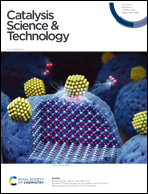Molybdenum-decorated V2O5–WO3/TiO2: surface engineering toward boosting the acid cycle and redox cycle of NH3-SCR†
Abstract
The accelerated acid cycle corresponding to NH3 activation and redox cycle that requires electron transfer between V4+ and V5+ are regarded the two essential factors determining low-temperature ammonia selective catalytic reduction (NH3-SCR). In this work, highly dispersed submonolayer Mo-decorated V2O5–WO3/TiO2 catalysts were developed for efficient NOx abatement at low temperature (<300 °C). The 7 wt% MoO3-decorated V2O5–WO3/TiO2 (7Mo–VW/Ti) catalyst presented outstanding NH3-SCR performance at 230–400 °C and displayed a high tolerance to SO2 and H2O. Compared with V2O5–WO3/TiO2, more active dimeric and polymeric vanadia species existed in the submonolayer 7Mo–VW/Ti catalyst, which were more reactive with NH3 at terminal V![[double bond, length as m-dash]](https://www.rsc.org/images/entities/char_e001.gif) O sites in the polynuclear structure. More Brønsted acid sites were formed due to the enrichment of polynuclear vanadia species and MoO3, which favors NH3 adsorption, thus speeding up the acid cycle. Additionally, the increased number of V4+ species produced by the MoO3 additive enhanced the redox properties, accelerating the process of the V5+/V4+ redox cycle. Therefore, the surface engineering of V2O5–WO3/TiO2 by MoO3 enhanced the acid and redox cycling of NH3-SCR. Furthermore, adsorbed NH3 species, especially when adsorbed on Brønsted acid sites, primarily reacted with gaseous NO and subsequently yielded N2 and H2O, following the Eley–Rideal mechanism.
O sites in the polynuclear structure. More Brønsted acid sites were formed due to the enrichment of polynuclear vanadia species and MoO3, which favors NH3 adsorption, thus speeding up the acid cycle. Additionally, the increased number of V4+ species produced by the MoO3 additive enhanced the redox properties, accelerating the process of the V5+/V4+ redox cycle. Therefore, the surface engineering of V2O5–WO3/TiO2 by MoO3 enhanced the acid and redox cycling of NH3-SCR. Furthermore, adsorbed NH3 species, especially when adsorbed on Brønsted acid sites, primarily reacted with gaseous NO and subsequently yielded N2 and H2O, following the Eley–Rideal mechanism.



 Please wait while we load your content...
Please wait while we load your content...